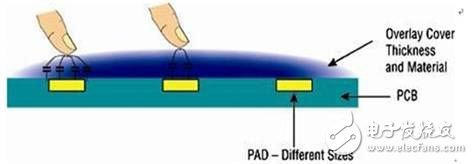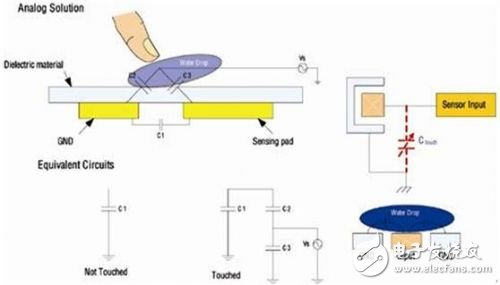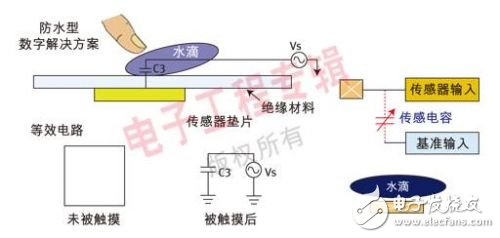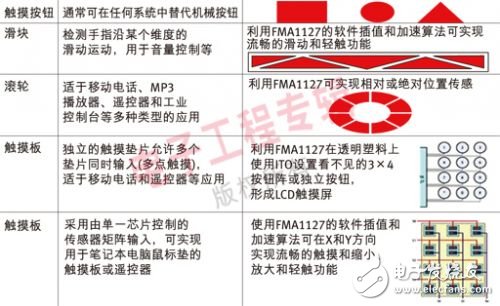New consumer electronics such as smartphones have made touchscreens popular, and touch sensors provide convenient control that can be used to control virtually any type of device.
Touch sensor controllers currently offer some general performance options and modalities such as sliders and proximity sensors. Advances in touch sensor technology have made sensor-driven interfaces easier to implement and more intuitive and simple for end users.
Most touch-sensing controllers work on the detected changes in capacitance (see Figure 1)—the capacitance between the finger and the metal sheet changes when an object or someone approaches or touches the conductive metal piece of the sensor. . Moving a conductive object (such as a finger) near the sensor will change the electric field line of the capacitive sensor and cause the capacitance to change. The control circuit measures the change in capacitance.
Industrial application systems have used this capacitance detection technology since many years to measure liquid level, humidity and material composition. This technology developed from these applications has evolved into an adult machine interface.
The touch sensor interface typically detects capacitance changes by measuring the impedance of the circuit connected to the sensor pads. The touch controller periodically measures the impedance of the sensor input channel and uses these values ​​to derive an internal reference, the calibration impedance. The controller determines whether a touch event has occurred based on this impedance value.
The simplified formula below shows the main effect of finger approach on the capacitance of the touch pad. This formula can be used to determine the capacitance and strength of the sensor shim.
* C indicates the capacitance in Farah
* A is the area of ​​a single metal gasket in square meters
* εr is the relative static dielectric constant of the material between the metal spacers (vacuum = 1)
* ε0 is the dielectric constant of free space = 8.854 & TImes; 10 (SUP /) -12 (/SUP) F / m
* D is the distance or spacing between the plates in meters.
In addition, the touch intensity increases as the pressure, touch area, or capacitance increases. A decrease in D is equivalent to an increase in capacitance or an increase in touch intensity.
This equation shows that the thickness of the film and its dielectric constant have a great influence on the touch intensity. The equation also shows that capacitive sensors are inherently sensitive to the characteristics of the surrounding environment and touch excitation – whether the touch comes from fingers, vinyl, rubber, cotton, leather or water (see Figure 1).

Figure 1: Touch sensitivity depends on the film material, gasket size and thickness.
Table 1 lists the dielectric constants of various commonly used coating materials. Based on these values, we can examine the application of touch sensors in the kitchen because these sensors are prone to splashing cooking oil in the kitchen.

Table 1: Dielectric constant
Typical edible oils such as olive oil or almond oil have a dielectric constant between 2.8 and 3.0. The dielectric constant of paraffin at 68 degrees Fahrenheit is between 2.2 and 4.7. The dielectric constant of these materials is close to or even less than the dielectric constant of the sensor's commonly used coated polycarbonate (2.9-3.2) or ABS material (2.87-3.0). Thus, the oil does not have much effect on the operation of the sensor.
In contrast, glycerin has a dielectric constant between 47 and 68 and water has a dielectric constant of about 80. Although the dielectric constant of these materials is higher than that of the film material, for touch sensors using digital touch detection technology (such as the technology used by ATLab's FMA1127 touch sensor controller), due to sensor pads and splashes The liquid on the ground is not grounded, and splashing these liquids will not cause any abnormal behavior.
Although the operational details and interfaces of the touch sensor depend on the specific application, in general, the capacitive sensor interface circuit and detection method are of both analog and digital types. One analog technique is measuring frequency or duty cycle, which varies due to the introduction of additional capacitance between the finger and ground (see Figure 2).

Figure 2: Analog touch scheme; may be affected by water droplets due to the need to use the reference ground
Using this technique and a high resolution analog-to-digital converter (ADC), the measured analog voltage can be converted to a digital code. Thanks to advances in mixed-signal technology, the latest capacitive/digital converters integrate high-performance analog front ends with low-power, high-performance ADCs.
One disadvantage of analog interface circuits is that capacitive sensors can be subject to elusive noise, crosstalk, and coupling. In addition, the dynamic range of the sensor output is limited by the supply voltage, which is decreasing as the semiconductor fabrication technology node shrinks.
If deep sub-micron CMOS technology is used to integrate sensor circuits with complex digital signal processing blocks on the same substrate, the situation becomes more challenging. To avoid external interference, the device may require the use of a software workspace, which increases the memory overhead and performance overhead of the microcontroller with which it interfaces.
The all-digital sensing method (see Figure 3) avoids problems associated with analog methods. The digital method detects changes in sensor capacitance by making the capacitor part of the RC delay line.

Figure 3: Digital touch scheme; robust performance in the presence of water droplets
The simple all-digital time/digital converter (TDC) of Figure 3 measures the difference between the delay line and the reference RC delay line and outputs a change in impedance. The effect of parasitic capacitance on the RC delay can be eliminated by power-on compensation.
The finger touches the sensor pad to increase the capacitance and thus increases the RC delay time and causes impedance changes. Comparing this impedance to the calibration impedance determines if a touch event has occurred. This sensing scheme can easily improve performance by adjusting the resistance of the RC delay line.
1 MCU interfaceWhether using analog or digital methods, the touch sensor controller can be connected to the microcontroller using a simple SPI or I (SUP/) 2 (/SUP) C interface. The MCU (master) typically exchanges data with the touch sensor controller (slave) in master-slave mode.
If the MCU does not have such a serial interface, you can use software to simulate the serial interface, but this approach increases memory and performance overhead. A chip that integrates a touch sensor controller with a microcontroller has been released recently.
2 Consumer electronics, home automation and industrial requirementsTouch sensor control provides a flexible, reliable and cost-effective alternative to traditional mechanical buttons, sliders, wheels and switches.
The latest touch sensors create the conditions for designers to use their creativity to hide or expose buttons or other forms of touchpad when developing interfaces. Table 2 and Figure 4 show different sensor shapes and applications.

Figure 4: Examples of sliders, scroll wheels, touch buttons, and proximity sensing applications

Table 2: Touch Control Solutions for Various Applications
Proximity touch control provides an attractive alternative to a simple interface that requires only one or two buttons. Proximity sensors are easy to integrate into the final product design and have long-term advantages such as low power consumption and long life.
Metal door handles are an ideal proximity sensor application. Extremely sensitive sensors can detect if a hand is approaching the door handle, and the system will power the security hardware that requires high power when it detects proximity. As part of the car alarm system, the system can record each proximity test and notify the owner (or permission to pass the phone) that someone has tried to pull the door multiple times.
When the metal object has an area of ​​10 mm (SUP/) 2 (/SUP) and the film thickness is 1 mm, the proximity sensor can detect the approach of the hand when the distance is greater than 2 inches. In addition to door handles, proximity touches can also be used for home appliances, MP3 players, remote controls, and mobile phones.
3 complex LCD touch screen solutionsOne end of the touch sensor lineage is a simple proximity sensor, and the other end is a complex touch LCD that provides a high-end feel for many common products.
Most notably, Apple's iPod and iPhone products have dramatically increased consumer expectations. From GPS devices and universal remotes to digital photo frames and networked refrigerators and washing machines, similar touch screen technology can enhance the functionality of a variety of electronic products.
Compact devices such as phones and GPS devices can use the flexible touch sensor PCB as the outer layer of the display. In these applications, capacitive touch modules can use transparent indium tin oxide (ITO) layers to achieve transparent sensor pads and leads on glass or plastic screens (see Figure 5).

Figure 5: Touch screen with FMA1127 and stacked arrangement of PCB and touch screen. The delay difference between the RC delay line formed by the detection capacitor and the reference RC delay line is compared by TDC. The use of differential signals eliminates or reduces the effects of correlated/coherent noise sources without the need for a formation.
Other applications include touch detection sensors that control the display to turn on. When no touch is detected, the display is turned off, minimizing system power consumption.
4 Trends in touch technologyTouch sensor switches are ideal for automotive applications because they have no moving parts and are easy to adapt to curved shapes. However, automotive applications place higher demands on touch technology, and automotive manufacturers require automotive-grade touch sensor controllers that offer low cost and wide operating temperature.
The key is to reduce the total implementation cost of the touch sensor solution. Affordable touch sensors provide the conditions for automotive design engineers to implement novel interface features.
Nintendo's Wii uses 3D positioning sensing technology. One of the latest innovations in computer-aided design is the 3-D mouse, where engineers can move the mouse in three dimensions to more intuitively control the product being designed.
In addition, Microsoft is demonstrating its vision for future user interfaces with Microsoft Surface touch computers. The interface uses a touch technology similar to that of an iPod, which recognizes multi-touch and actual objects (such as brushes) and interacts intuitively with contact events in an intuitive manner.
Indoor Led Display,Indoor Advertising Led Display Screen,Indoor Led Screen,Led Screen Indoor
ShenZhen Megagem Tech Co.,Ltd , https://www.megleddisplay.com
![<?echo $_SERVER['SERVER_NAME'];?>](/template/twentyseventeen/skin/images/header.jpg)